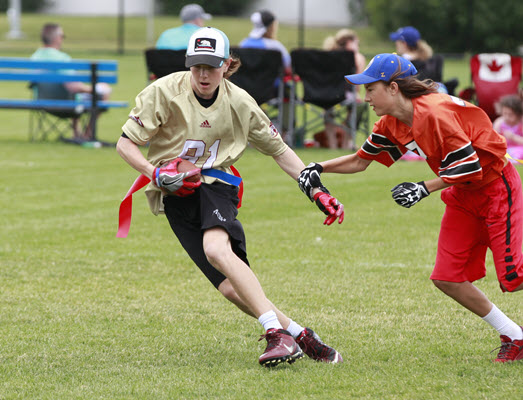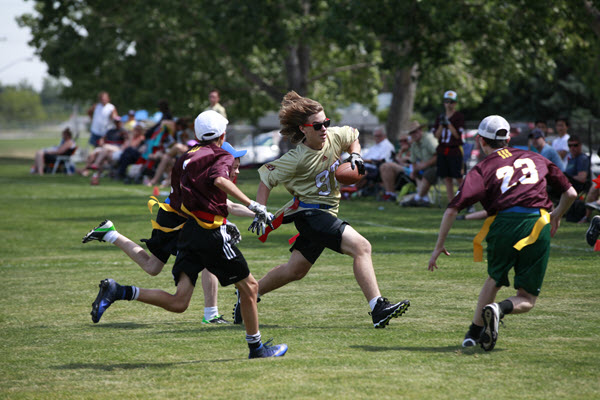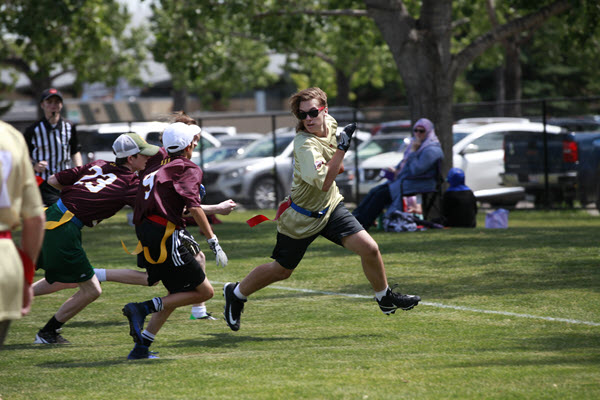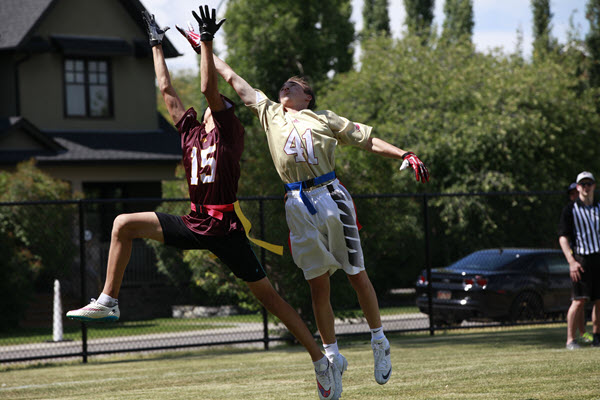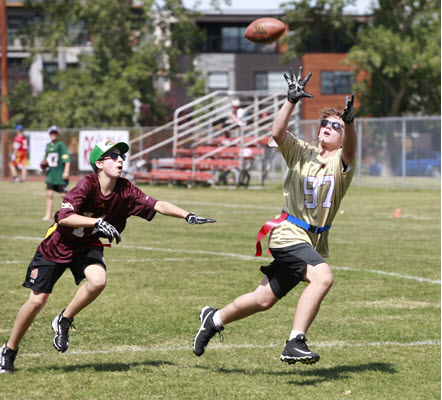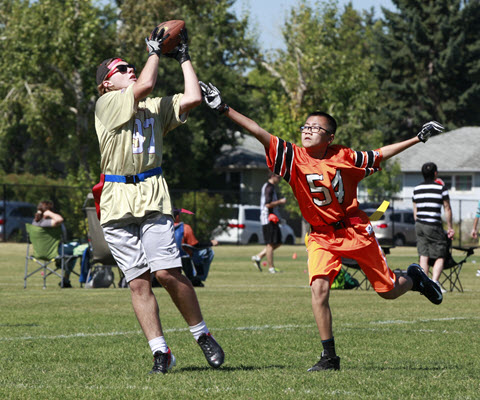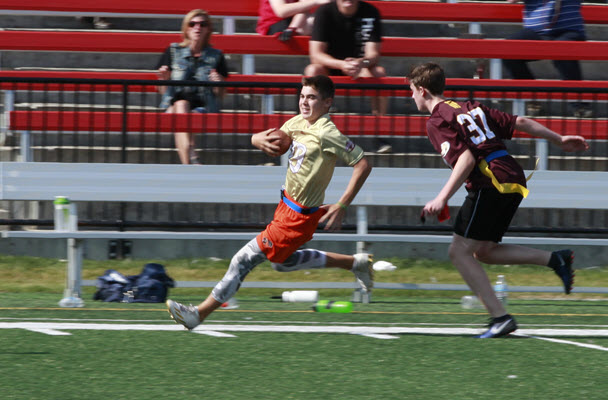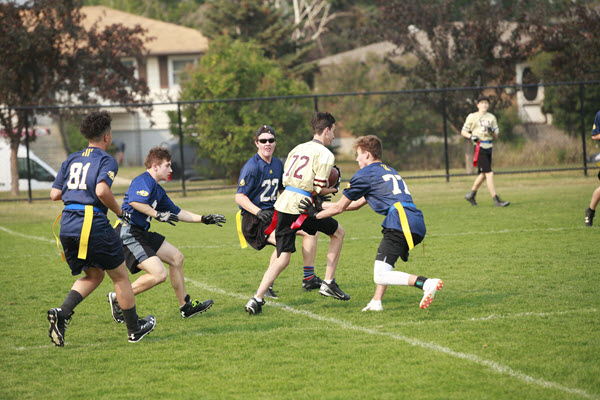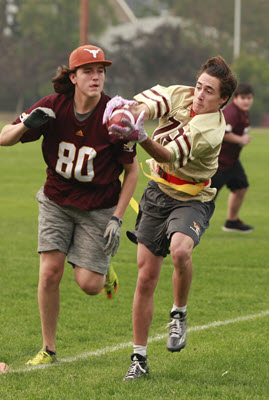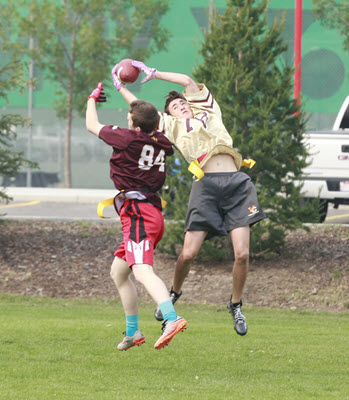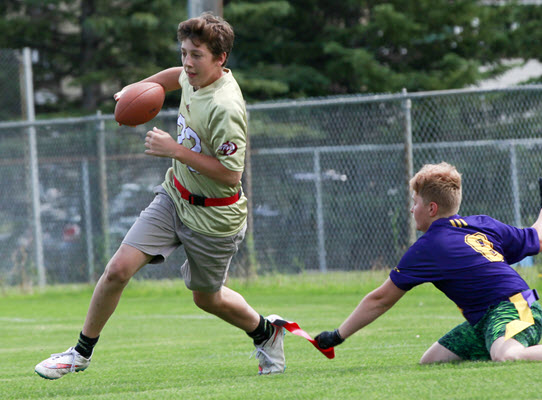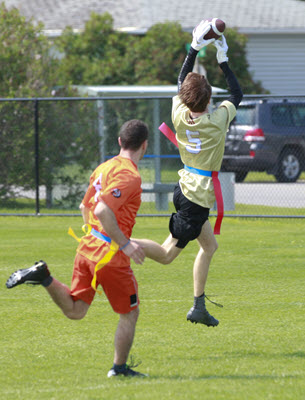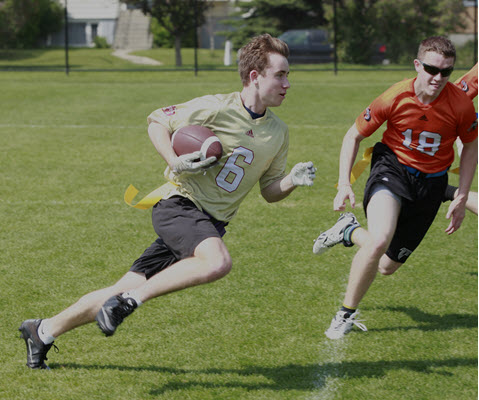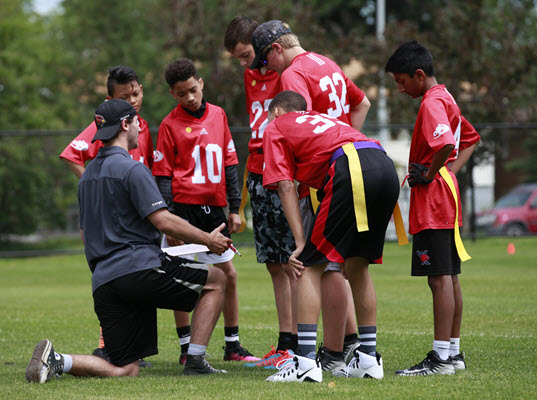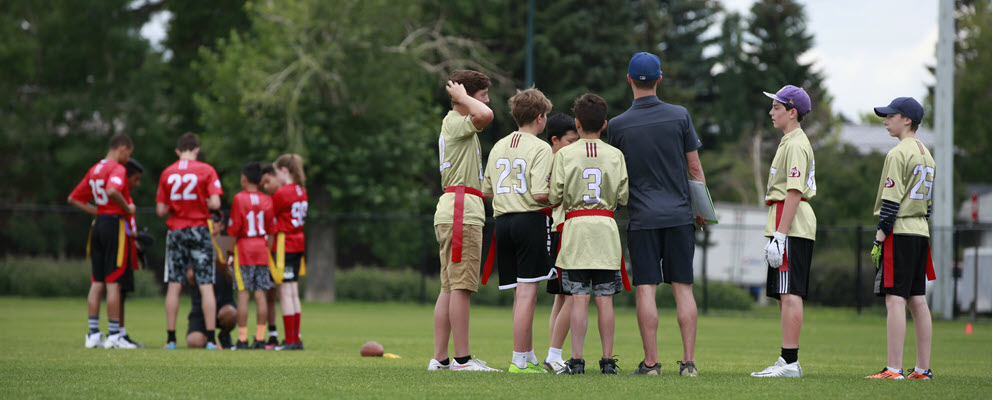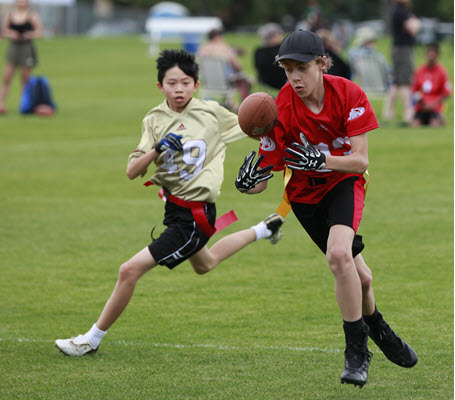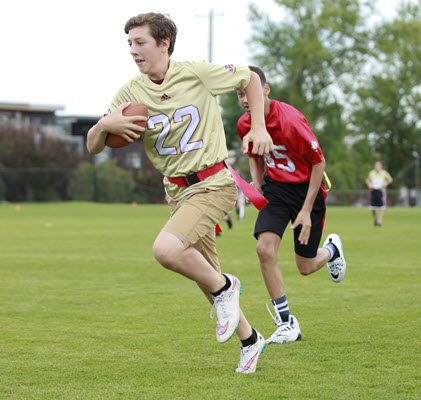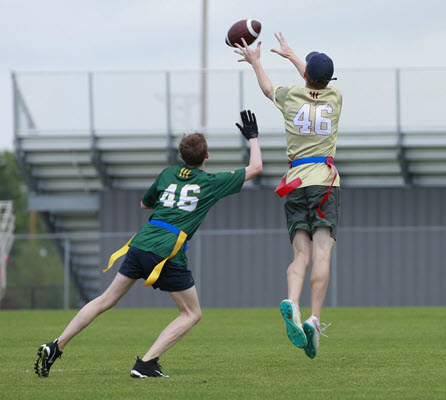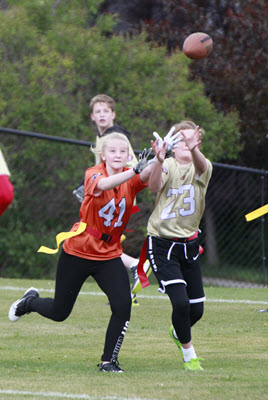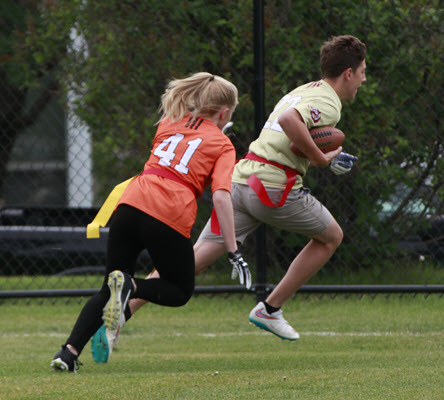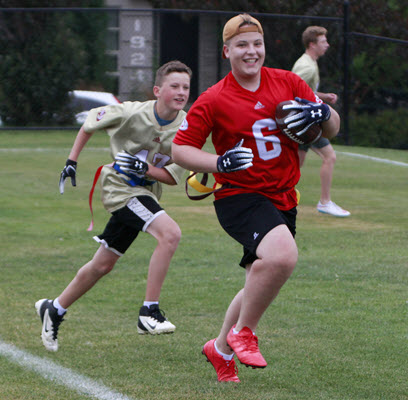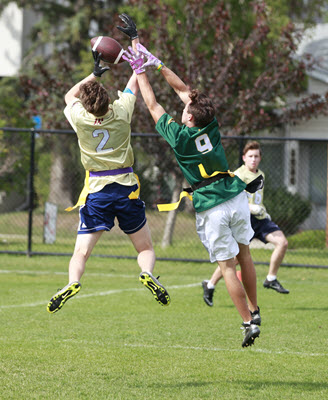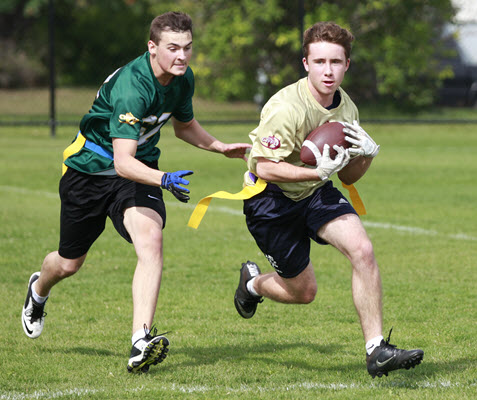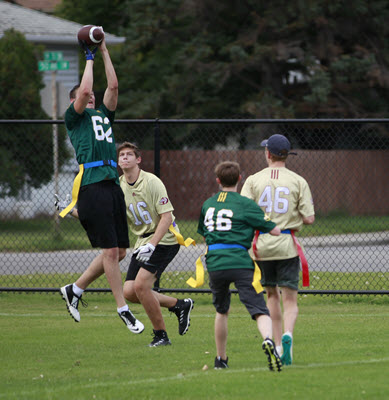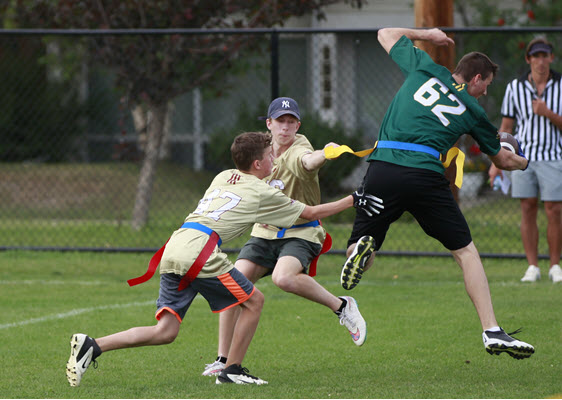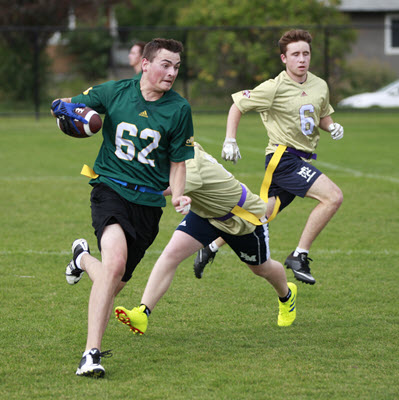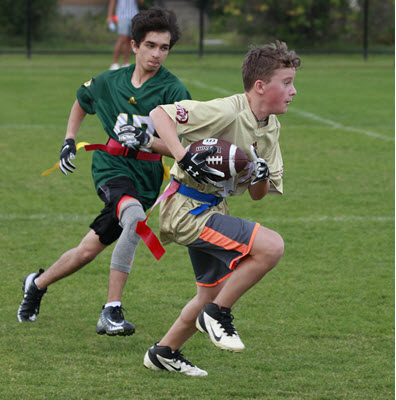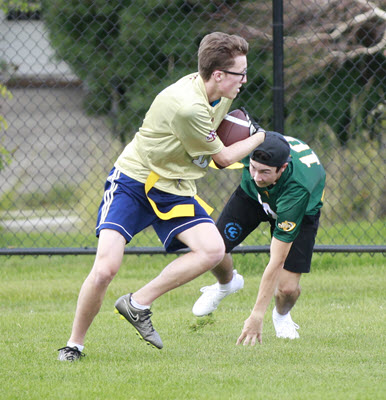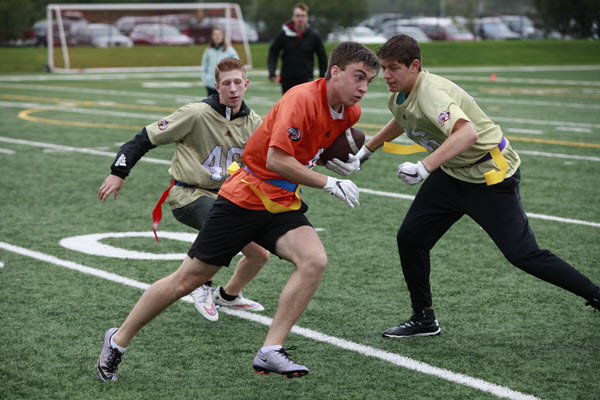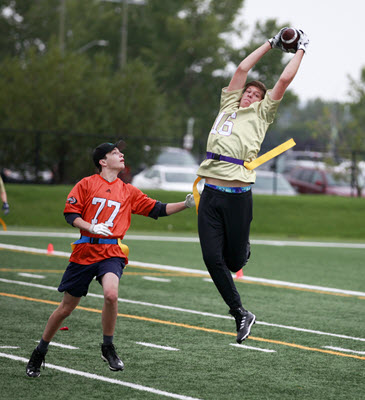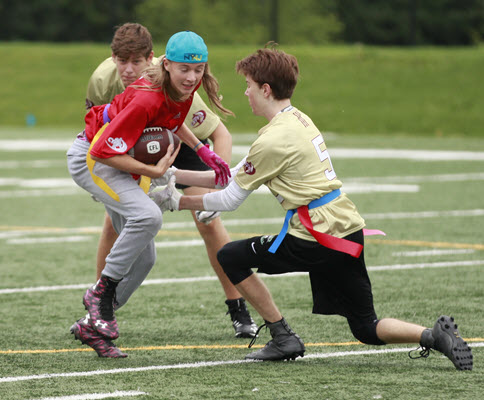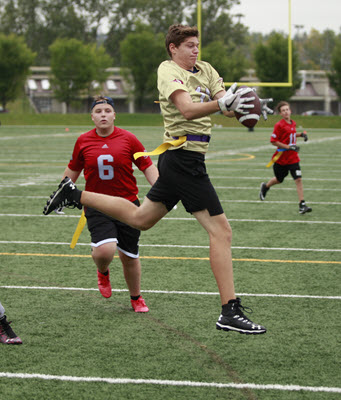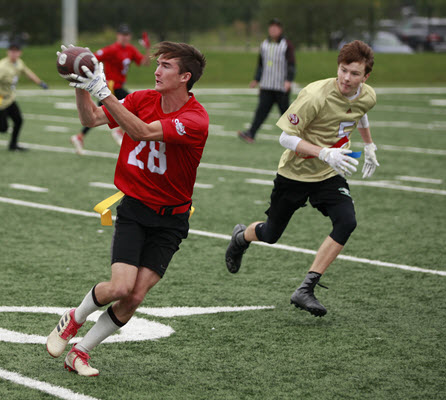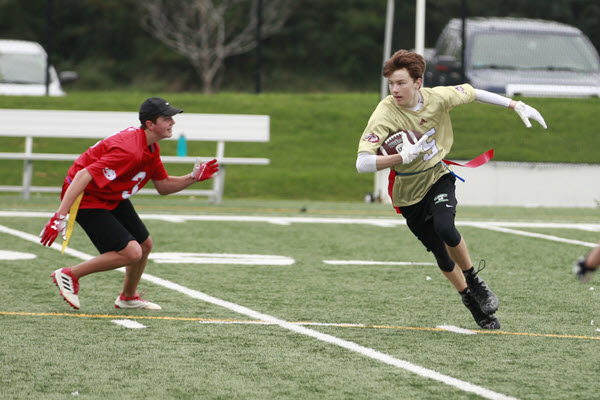CROSSING PATTERNS (Illegal Procedure - 5 yard penalty)
To keep games with minimal contact CROSSING patterns ARE NOT allowed. Players on the same team should not be within 5 yards of each other when running a pattern or when running around on a broken play. If two players cross and they are within 5 yards of each other than a flag will be thrown, and an Illegal Procedure penalty will be called.
TEAM REQUIREMENTS
During the regular season games all players that are present for a game must play at least half of the game on offense and half of the game on defense or be in a player rotation every 4 plays.
Each team must comply with all other rules, regulations, procedures and obligations outlined in this document.
RULES AND REGULATIONS
The Team
- The team will consist of (12 or 13) players with six (6) players on the field at one time.
- A minimum of five (5) players will be considered as a playable entity to commence a 5 on 5 contest.
- Players can be picked up from a lower division if you are short of players because of holidays or injuries.
Equipment
- No blocking devices or helmets are allowed. Volleyball elbow and kneepads are allowed. If a player has a broken arm or wrist and is playing with a cast, the cast must be padded to the referee's satisfaction. Use of a cast, as a club will not be tolerated.
- Soccer or football cleats are strongly recommended, but well fitting shoes, suitable to running are acceptable options. Baseball cleats (metal spikes) are not permitted.
- At the start of the season each team will be supplied with flags and team jerseys and two footballs.
- Metal Knee Braces must be covered (I.E. Sweat pants... etc.).
The Field
- The standard fields will be 100 yards long, fifty (50) yards wide, with twenty (20) yard increments, two ten (10) yard end zones. Lower divisions will start possessions at the centre field.
- Depending on field location and division the field sizes may be modified.
Officiating
- Two officials will be assigned to each game referee association.
- The head referee will be responsible for score keeping and league standings.
- The head referee will fill out an incident report for any player committing a roughing penalty. A player will be ejected if they commit two (10 yard) roughing penalties in one game.
Schedule
- There will be no grace on scheduled starting times.
- In most cases the games will be played regardless of the weather conditions. Should your game be canceled due to weather conditions on the last regular season game in August then your game will be considered as a tie game and will not be rescheduled. Otherwise every effort will be made to reschedule the games. Some teams may play 2 games on the same Saturday day.
Rosters and Player Rotations
- All teams will be expected to fill out and have a parent administer the Roster and Player Rotation form.
Playoffs
- All teams will make the playoffs
- Division standings if there is a tie will be determined as follows:
- Record against one another
- Number of wins
- Total point differential (points for and against record)
- Coin flip
Disciplinary Action
- Cases of abusing referees, fighting, extremely rough play, etc., will be dealt with on an individual basis and subject to the minimum penalties outlined below. Harsher penalties will be at the discretion of the executive. Referees must formally report any incidents.
REGULAR SEASON GAMES
Regular season games are never to be a forfeit and it is the responsibility of both coaches to have a game played. Coaches have several options:
- Play 5 on 5
- Make the field narrower and play 4 on 4
- Pull players from a younger division
- Pull players from the same division (It is preferred that the teams playing each other would share one or two players but can pull players from any team in the division).
- Player could be pulled from a higher division if both coaches agree to this arrangement, but if both team have 5 players then they should play 5 on 5.
Rules of the Game
The Standard Canadian Amateur Football rules apply for cases not mentioned below:
- Teams will have five or six downs to cross an increment (depending on division). Once an increment is crossed, the team is awarded five or six more downs to cross the next increment. Crossing an increment that has already been crossed once during a possession does not result in a first down when crossed for the second time.
- Following a touchdown and point after attempt, the opposing team gains possession on their own twenty (20) yard line.
- P.A.T. attempts are to be passing plays only. P.A.T. attempts will be scrimmaged from either the three (3) or the ten (10) yard line. The offense has the option. One (1) point will be awarded if successful from the three (3) yard line and two (2) points will be awarded if successful from the ten (10) yard line.
- There is no punting. A team simply relinquishes control following their last down and the ball is brought out to center field.
- All forward passes must travel at least 5 yards in the air before being caught (no lateral passes are allowed behind the line of scrimmage or in the lower divisions).
- The number of receivers on each side of centre field must be balanced.
- All receivers must be at least 5 yards apart from one other. Failure to do so will result in a warning or an illegal procedure penalty (5-yard penalty).
- If an offensive player runs his or her pattern close to a teammate (within 5 yards). Then a 5-yard Illegal Pick / Crossing Pattern penalty will be called.
- Coaches - Each coach is responsible for his or her players conduct on the field. Coaches shall conduct themselves in a manner, which demonstrates good sportsmanship to their team, and shall encourage their players to perform in the same manner. Coaches must be in complete control of all their players during the game. Coaches may be ejected from the game for tolerating or participating inappropriately. One coach from each team will be allowed on the field to assist players in organization and calling plays. No coaching is to be done after the snap of the ball by the coach that is on the field.
- No blocking is allowed.
- All players are eligible pass receivers.
- The Team winning the coin toss has the option start with the ball (have last possession) or start with the ball in the second half (depending .
- The losing team will have choice of end if using full field. Teams will switch ends in the second half.
- In the lower divisions each team will get equal number of positions of the ball with the ball starting at mid-field. NOTE: Should a game be running low on time at the end of the game the last positions can be started at the 20 yard line to ensure both teams have equal number of possession and games do not go into overtime.
- It is the responsibility of each player to ensure that his flags are properly attached.
- If a flag inadvertently falls off or was never on, a player will be considered tackled when he is touched.
- If a defensive player pulls a flag before the offensive player gains control of the ball, but after the ball was touched by the offensive player. The player will be considered tackled and the ball will be scrimmage were the ball was when the players flag was pulled.
- If a defensive player deliberately pulls an offensive players flag when they are not in possession of the ball, they will be given an unsportsmanlike conduct penalty.
- Ties will be allowed to stand except
for playoff games. In playoffs, tie games will be decided as follows:
- Lower seeded starting on offense or defense.
- Overtime will commence at the 20-yard line (60 yards to the end zone).
- The teams will be given 4 plays to score or move the ball the farthest.
- If both teams score in 4 or less plays, then we will start again with 3 plays. Also, the team that started with the ball in the first over time will go second in the second overtime.
- Teams MUST continue their normal player rotations (everyone should play in the overtime)
- The procedure will continue until a winner is declared.
- The play will be considered dead when anything other than hands or feet of the ball carrier touches the ground.
- Protecting the flags is illegal. When a player is running with the ball, the onus is on him to keep his hands free from a position in which he is protecting his flags. The ball will be dead at the point of infraction for any player that guards their flag(s).
- Charging occurs when a defensive player is stationary or giving ground and the offensive player initiates contact. The ball carrier shall not attempt to run through his opponent. Once the defensive player has assumed his position pull a player�??�?�¢??s flag(s), the onus is on the ball carrier to avoid anything other than incidental contact.
- The offensive team will have thirty (30) seconds to snap the ball from center.
- No tackling or holding is allowed.
- Each team is allowed two (2) one minute time outs per game. Any player on the field may call the time out.
- The quarterback may not cross the line of scrimmage while having possession of the ball unless he has first relinquished control of the ball to another player on his own team (forward pass).
- All forward passes must travel at least 5 yards in the air before being caught
- NO lateral passes are allowed until a forward pass is completed.
- The player who first has possession of the ball following the snap from center is deemed to be the quarterback on each particular play.
- The quarterback must be at least 5 yards back from the line of scrimmage when he catches the snap from the center. Should the quarterback drop the snap from the center or the ball hits the ground the quarterback has until the steamboats are up and the rusher is within 3 yards of him to get control of the ball otherwise the referee will call the play dead.
- The center must snap the ball through his legs to the quarterback.
- CENTERS are to be given an unobstructed path directly up field for 4 yards in the lower division and 7 yards in Midget. In the Midget division this will reduce problems with rusher interference.
- In the lower division it will be 4 STEAMBOATS with the rusher being able to cross the line on the �¢??R�¢?? of four. In the Midget (Oldest division) RUSHERS are to line up 15 yards back and 2 yards on either side of the centre. He/she is given an unobstructed direct path to the line of SCRIMMAGE, but once they pass the centre or the centre has cleared the area they can take a direct path to the QB provide they don't interfere with a offensive players route.
- Teams must play MAN-ON-MAN Defense and be within 8 yards of the line of scrimmage when the ball is snapped. Only the Midget teams are allowed to play ZONE defense but must play MAN-ON-MAN on converts. NOTE: In lower division when playing Man-on-Man defense. At no time are players allowed to help another player until the ball is thrown.
Divisions that have a set number of plays in a half:
Penalties in the last 8 plays of the game\half will not count as a play if they repeat the down.
Example: On 4th and 20 yards. The Offense throws a 5 yard hook and Defense gets called for holding.
- If the Offense takes 5 yard gain and penalty and it is now 5th down the play counts.
- Should the Offense decide to not take the gain but takes the penalty from the line of scrimmage (10 yards). Then the down will be repeated, and the play will not count.
CLARIFICATION'S
- Inadvertent Whistle - When the whistle is blown inadvertently. If the ball is:
- Offensive possession - offense has choice of
- ball at line of scrimmage and down repeated
- ball at point of possession and downs continue.
- Defensive possession - ball is at point of possession and first down.
- In the air on a forward pass - ball is at line of scrimmage and down repeated.
- Penalties during a Convert - No penalties will have yardage applied on the next possession unless it is a dead ball foul or a roughing call
- Coaches - On field coaches may communicate with the referee and are entitled to a ruling explanation.
- Forward passes - Only one forward pass is allowed.
- Tipped Ball - If a receiver or a pass defender tips the ball towards the opponent�??�?�¢??s goal to a teammate, the catch is legal, and the play continues until the player with the ball is flagged. Should a player deliberately direct the ball towards the opponent�??�?�¢??s goal to a teammate, the catch is legal. However, the ball may not be advanced and is scrimmaged at the point where the ball was directed forward.
- Defensive Obstruction - Is an illegal defensive technique when a defensive player that is not stationary or giving ground impedes a receiver�??�?�¢??s intended path with or without contacting the opponent. Five (5) yard penalty from line of scrimmage and down over.
- Defensive (NON-TARGET AREA)
- Ten (10) yard penalty from line of scrimmage and down over. More than likely ruled as holding.
- Offensive (NON-TARGET AREA) is a 10 yard penalty and down over.
- Offensive (TARGET AREA) is a 10 yard penalty and a loss of down unless it is the final down then the defensive team would get the ball first down at the line of scrimmage.
- Defensive (TARGET AREA)
- The offensive team will receive an automatic first down.
- The ball will be placed at the point of infraction.
- If the interference occurs less than ten-yards from the line of scrimmage, then a ten-yard penalty will be applied from the line of scrimmage.
- If the interference occurs in the end zone the offensive team would get a first down on the one yard line.
- Double Fouls (two or more infractions to one team)
The non-offending team takes its choice of the penalties unless one of the fouls is roughing. If one of the fouls is roughing, it shall be added to the penalty chosen. - Dual Fouls (penalties to each team) - The penalties shall be applied in the order that they occurred. The penalties shall be applied as follows:
- If the first foul occurs prior to distance being gained, the penalties shall be applied from the line of scrimmage.
- If the first foul occurs after distance gained or change of possession, the penalty shall be applied from the point the ball was held at the time of the first foul.
- If either team declines a penalty, the remaining penalty shall be treated as a single foul.
- Game Ejection (Fighting, Extreme Rough Play or 2 Roughing Penalty. Players will be ejected from a game for Fighting, Extremely Rough Play or if they receive 2 Roughing Penalties in one game.
PENALTIES
Infraction Yardage Point of Assessment
NOTE: If there aren't enough yards to apply the penalty from the original line of scrimmage then it will be put on the one yard line and down repeated.
- Flagging 5 yards - Point of infraction Down Counts
- Charging 10 yards - Point of infraction Down Counts
- Tackling 5 yards (Minor) - Point of infraction Down Counts
- Tackling 5 yards (Major) - Point of infraction Down Counts
- Roughing (Minor Foul) 5 yards - added to the end of the play or line of scrimmage whichever gives the greater advantage and down counts.
- Roughing (Defensive) 15 yards - added to the end of the play or line of scrimmage whichever gives the greater advantage. Automatic 1st down.
- Roughing (Offensive) 15 yards - line of scrimmage Down Over
- Roughing-Deliberate - (Extremely Rough Play) 25 yards plus player ejection. Line of scrimmage First down (Defense) Down over (Offensive)
- Blocking - ball is dead when infraction occurred
- Illegal Procedure 5 yards - Line of scrimmage Down Over
- Defensive Obstruction 5 yards - line of scrimmage Down Over
- Pass Interference (Offensive)
- Non-target area 10 Line of scrimmage Down Over
- Target area 10 Line of scrimmage Loss of Down
- Pass Interference (Defensive)
- Non-target area 10 Line of scrimmage Down Repeated
- Target area Auto first down at point of infraction or at the one-yard line if it occurs in the end zone.
- Unsportsmanlike Conduct 10 yards - Line of scrimmage and down over
- Time Count 5 Line of scrimmage Down Over
- Fighting 25+Ejection
*********************************************************************************************************************************
PICKING UP PLAYERS FROM LOWER DIVISIONS:
- If you team is short on players, you can pick up players from a lower division.
- Referees should be advised that you are picking up players.
- The MAX number of players with lower division players is (8) eight players.
- If regular players show up late then the lower players should be thanked and sent home
GLENMORE FIELDS SIZE AND DIRECTION:
Coach Throw ALL Divisions
- Ball is placed on the west 40-yard line after every possession change (includes turnover / interceptions)
- Teams will drive the ball towards the east end zone.
Player Throw PeeWee & Bantam
- The fields are setup every week to be the same size as the Acadia fields (two 10-yard end zones, and THREE 20-yard zones).
- Teams play both directions.
- If there is a turnover on downs the ball goes to the 40-yard line.
- If there is an interception the ball goes to were ever the player is flagged OR the 40-yard line (whichever is closer to the goal line).
Player Throw Midget
- The fields are changed to be the same size as previous years (two 10-yard end zones, and FOUR 20-yard zones). Teams play both directions. Teams start at the 40-yard line at the start of the first and second half. After a touchdown teams will start at their 20-yard line. If there is turnover on downs or interception the ball goes to were ever the ball is or the player was flagged.
ACADIA FIELDS SIZE AND DIRECTION:
Coach Throw ALL Divisions
- Ball is placed on the west 40-yard line after every possession change (includes turnover / interceptions)
- Teams will drive the ball towards the east end zone (lower fields) – possible west end zone (upper field – depends on the Sun and field conditions)
Player Throw PeeWee & Bantam
- Teams play both directions.
- If there is a turnover on downs the ball goes to the 40-yard line.
- If there is an interception the ball goes to were ever the player is flagged OR the 40-yard line (whichever is closer to the goal line).
Player Throw Midget
- Teams play both directions.
- Teams start at the 40-yard line at the start of the half and after a touchdown.
- If there is turnover on downs or interception the ball goes to were ever the ball is or the player was flagged.
*********************************************************************************************************************************
OVERTIME RULES:
PLAYERS THAT ARE CURRENTLY ON THE FIELD WILL STAY FOR THE FIRST 2 PLAYS OF OVERTIME & WILL THEN ROTATE EVERY SECOND PLAY.
1. Lower ranked team will get the first choice of ball 1st or 2nd.
2. Teams will start on the 40 yard line and be given up to 3 plays to score or get maximum yards.
3. If both teams score than choice of ball will alternate
4. Teams will start on the 40 with 2 plays (then 1 until a winner is decided).
